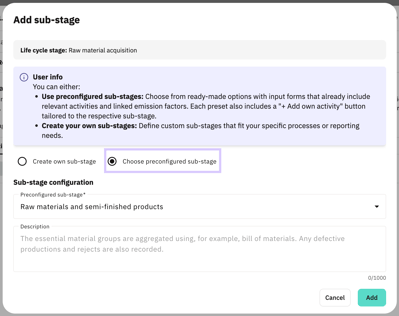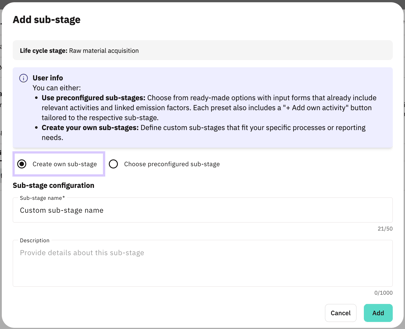Base data
All report-relevant information required to create a full or partial PCF report is recorded in the Base data tab.
The section is divided into two sub-tabs:
1) General information
2) Report configuration
1) General information
Product description:
To calculate the PCF, a concise product description is first recorded that clearly identifies the product under consideration. This description is also output in the final PDF report.
Selecting the system boundary:
The next step is to define the system boundary. You can choose between different perspectives:
- Cradle-to-gate: Only the phases of raw material acquisition and production up to leaving the factory gate are considered. Distribution, use and end-of-life treatment are not taken into account.
- Cradle-to-grave: Covers the entire life cycle of a product - from the acquisition of raw materials to production, distribution, use and disposal of the product.
Definition of the reference value:
The reference value is defined after the system boundary has been defined.
- Only the declared unit is available for the cradle-to-gate system boundary. It describes the product independently of a defined use, e.g. 1 kg of sheet steel. It is particularly useful for products that do not (yet) have a clearly defined use, e.g. intermediate products. This makes it possible to communicate the environmental impact if the end product has not yet been defined or enables different uses.
- Both the declared unit and the functional unit are available for the cradle-to-grave system boundary. As a rule, however, the functional unit is preferred here, as it describes the specific benefit of the product in clearly defined, quantifiable units, e.g. the transport of a person over 100,000 km in a car with an internal combustion engine, whereby the car represents the product under consideration. The use of the functional unit thus enables a transparent, consistent and comparable assessment of environmental impacts over the entire life cycle, especially for products with the same benefits (e.g. electric car and combustion engine).
- Note: In exceptional cases, the declared unit can also be used for the cradle-to-grave system boundary, for example if individual life cycle phases are excluded (e.g. use due to missing data).
Definition of the reference flow:
The reference flow is only required when using the functional unit. It describes the product quantity required to fulfil the benefit defined in the functional unit. This means that all required input and output data in the life cycle can be related to this benefit.
For a car with an internal combustion engine, the reference flow could be as follows:
The quantity of vehicle and operating materials required to fulfil the transport of one person over 100,000 km. This includes, among other things:
- The vehicle (e.g. 1,400 kg of material input)
- The fuel consumption over 100,000 km (e.g. 7,000 litres of petrol)
- Maintenance and spare parts (e.g. 25 litres of oil)
- End-of-life treatment (1 vehicle)
All these input parameters must be taken into account when recording consumption and emissions data in order to calculate the full PCF for the functional unit. If this PCF is then compared with that of another vehicle, e.g. the PCF of an electric car, its reference flow must be determined in the same way, based on the same functional unit:
- The vehicle (e.g. 1,400 kg material input, plus material for battery if applicable).
- Electricity consumption over 100,000 km (e.g. 15,000 kWh of electricity)
- Maintenance and spare parts (e.g. battery replacement)
- End-of-life treatment (1 vehicle)
Important: All consumption data must always be recorded in relation to the selected reference value and reference flow. A comparable, transparent assessment of the environmental impact of different products is only possible if the reference value and reference flow are defined uniformly for different PCFs.
Specification of the number and unit of the product quantity under consideration:
The number and unit of the product quantity under consideration is now recorded. Units can be selected according to weight (g, kg, t, short-ton, lb), volume (ml, L, m3, scf, gal, bbl), area (m2, ha, km2, ft2), length (m, km, ft, mi, nmi, pkm, pmi, tkm, tmi, short-ton-mi), energy (kWh, MWh, Wh, GWh, MJ, GJ, TJ), currency (EUR, USD) or other (nights, number, %).
Information on the total production volume of the product in the reference period:
The total production volume of the product in the reference period is also recorded. This information is essential for scaling the emission values to the total production output. However, the information is not included in the calculation of total CO2e.
Comments on the PDF report:
Finally, there is the option to enter additional comments, explanations or methodological notes on the PCF report in the Comments field. This text is also displayed in the final PDF report and can help to make the accounting more comprehensible.
2) Report configuration
With the report configuration, the structural setup of a Product Carbon Footprint can be flexibly adapted to the company’s real processes. The defined sub-stages determine where activities are entered in the Data tab and how they are displayed in the Analysis section.
For example, the life cycle stage production can be divided into concrete process steps to enable a more precise representation and evaluation of emission sources.
Note: Sub-stages can currently only be created on one level (Level 1). A more detailed structure (Level 2) is under development and will be available soon.
The report configuration enables:
-
a flexible and company-specific modeling of the report structure
-
the use of preconfigured sub-stages
-
the creation of custom sub-stages
2.1) Where is the report configuration set up?

The configuration of sub-stages takes place in the Base data section of the PCF report. There, it can be defined which sub-stages should exist within each life cycle stage. This structure is automatically transferred to the Data tab and forms the basis for entering activities.
Note: Only users with the Administrator role can view and modify the report configuration. All other users work in the Data tab with the structure that has been set up.
2.2) How is it configured?
By default, each report is set up with the Base configuration. It includes preconfigured sub-stages and is ready for immediate use. As soon as a sub-stage is added, edited, or deleted, the change becomes visible in the Data tab — where activities are then recorded according to the updated structure.

Note: It is recommended to define the structure before entering activities.
Creating sub-stages
Two types of sub-stages can be used in each life cycle stage:
-
Preconfigured sub-stages: Include ready-made input forms and predefined activities in the dropdown. This is particularly helpful when starting data entry.

-
Custom sub-stages: Freely nameable process steps that can be adapted to specific workflows.

Both types can be combined as needed.
Editing or deleting sub-stages
Both editing and deleting sub-stages is done via the pencil icon.

Custom sub-stages can be renamed or deleted at any time. Their description can also be added, modified, or removed at any time.
Preconfigured sub-stages cannot be renamed, but their description can be edited at any time. A default description is already provided and can be replaced if needed. Preconfigured sub-stages can also be deleted.
Note: When a sub-stage is deleted, all activities contained within it are permanently deleted.
Rules for naming and structuring
-
The name of a custom sub-stage must be unique within the life cycle stage.
-
A name cannot be used if a preconfigured sub-stage with the same name already exists.
-
Structural changes become effective immediately in the Data tab.
Creating sub-stages when activities already exist
If sub-stages are added while activities still exist directly on the life cycle stage level, these activities are automatically assigned to the newly created sub-stage.
Important: This automatic assignment cannot be undone. Moving activities afterward is only possible via CSV download and upload.
![VERSO_Logo-1.png]](https://helpdesk.verso.de/hs-fs/hubfs/Globale%20Design-Elemente/VERSO_Logo-1.png?height=50&name=VERSO_Logo-1.png)